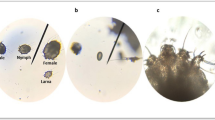Summary
By examining mycelial cultures at regular intervals during incubation at 37° C in cysteine-enriched media, it was possible to detect differences in the conversion properties of six isolates ofHistoplasma capsulatum. The organisms varied according to conversion ability, rate and degree of transformation following yeast initiation, and cysteine sensitivity. These findings were unrelated to infectivity of the mycelial phase for mice as determined by percentage recovery of isolates from the cultured organs of inoculated animals.
Similar content being viewed by others
Literature
Ajello, L. 1954. Occurrence of Histoplasma capsulatum and other human pathogenic molds in Panamanian soils. Amer. J. trop. Med. Hyg.3: 897–904.
Ajello, L. &L. C. Runyon. 1953. Infection of mice with single spores of Histoplasma capsulatum. J. Bact.66: 34–40.
Ajello, L. &L. D. Zeidberg. 1951. Isolation of Histoplasma capsulatum and Allescheria boydii from soil. Science113: 662.
Binford, C. H. 1955. Histoplasmosis. Tissue reactions and morphologic variation of the fungus. Amer. J. clin. Path.25: 25–36.
Brandt, F. A. 1950. Early tissue reactions to a South African strain of Histoplasma capsulatum in laboratory animals. J. Path. Bact.62: 259–269.
Campbell, C. C. 1947. Reverting Histoplasma capsulatum to the yeast phase. J. Bact.54: 263–264.
Cazin, J. W., F. McCullock &J. L. Brown. 1962. Isolation of Histoplasma capsulatum, Allescheria boydii and Microsporum gypseum from Iowa soils. J. Iowa med. Soc.52: 348–351.
Conant, N. F. 1941. A cultural study of the life cycle of Histoplasma capsulatum Darling 1906. J. Bact.41: 563–578.
DeMonbreun, W. A. 1934. The cultivation and culture characteristics of Darling's Histoplasma capsulatum. Amer. J. trop. Med.14: 93–125.
Dowding, E. S. 1948. The spores of Histoplasma. Canad. J. Res. E.26: 265–273.
Edwards, M. R., E. L. Hazen &G. A. Edwards. 1959. The micromorphology of the tuberculate spores of Histoplasma capsulatum. Canad. J. Microbiol.6: 65–70.
Emmons, C. W. 1950. Isolation of Histoplasma capsulatum from soil. Publ. Hlth. Rep.64: 892–896.
Goos, R. D. 1964. Germination of the macroconidium of Histoplasma capsulatum. Mycologia56: 667–671.
Haley, L. D. 1952. “Saprophytic form” of Histoplasma capsulatum in vivo. Yale J. Biol. Med.24: 381–383.
Hansmann, G. H. &J. R. Schenken. 1934. A unique infection of man caused by a new yeast-like organism, a pathogenic member of the genus Sepedonium. Amer. J. Path.10: 731–738.
Howard, D. H. 1959. Observations on tissue cultures of mouse peritoneal exudates inoculated with Histoplasma capsulatum. J. Bact.78: 69–78.
Howard, D. H. 1963. The morphogenesis of the parasitic forms of dimorphic fungi. Mycopath. et Mycol. appl.18: 127–139.
Howell, A. 1940. Studies on Histoplasma capsulatum and similar form species. II. Effect of temperature. Mycologia32: 671–680.
Kurung, J. M. &D. Yegian. 1954. Medium for the maintenance and conversion of Histoplasma capsulatum to the yeast-like phase. Amer. J. clin. Path.24: 505–508.
Larsh, H. W. 1960. Diagnostic Procedures in the study of Histoplasma capsulatum. p. 153. InH. S. Sweany (ed.) Histoplasmosis. Charles C. Thomas Co., Springfield, Ill.
Larsh, H. W., A. Hinton &S. L. Silberg. 1956. Conversion and maintenance of Histoplasma capsulatum in tissue culture. Proc. Soc. exp. Biol.93: 612–615.
Milne, H. A. 1957. The morphology and cytochemistry of H. capsulatum. J. Med. Lab. Tech.14: 142–163.
Northey, W. T. &L. D. Brooks. 1962. In vitro conversion of Histoplasma capsulatum. J. Bact.84: 577–580.
Pine L. 1954. Studies on the growth of Histoplasma capsulatum I. Growth of the yeast phase in liquid media. J. Bact.68: 671–679.
Pine, L. 1957. Studies on the growth of Histoplasma capsulatum III. Effect of thiamine and other vitamins on the growth of the yeast and mycelial phases of Histoplasma capsulatum. J. Bact.74: 239–245.
Pine, L. 1960. Morphological and Physiological Characteristics of Histoplasma
Pine, L. 1962. Nutritional determinants of morphology. pp. 84–107. InG. Dalldorf (ed.). Fungi and fungus diseases. Charles C. Thomas Co., Springfield, Ill.
Pine, L. &C. L. Peacock. 1958. Studies on the growth of Histoplasma capsulatum IV. Factors influencing conversion of the mycelial phase to the yeast phase. J. Bact.75: 167–174.
Pine, L. &R. E. Webster. 1962. Conversion of strains of Histoplasma capsulatum. J. Bact.83: 149–157.
Riddel, R. W. 1950. Permanent stained mycological preparations obtained by slide culture. Mycologia42: 265–270.
Salvin, S. B. 1949. Cysteine and related compounds in the growth of the yeastlike phase of Histoplasma capsulatum. J. infect. Dis84: 275–283.
Procknow, J. J. 1960. The pathogenesis of histoplasmosis in animals. pp. 246–267. InH. C. Sweany (ed.) Histoplasmosis. Charles C. Thomas Co., Springfield, Ill.
Scherr, G. H. 1956. The influence of temperature and —SH groups on the growth of dimorphic pathogenic fungi. Bact. Proc. 1956. 85.
Scherr, G. H. 1957. Studies on the dimorphism of Histoplasma capsulatum I. The roles of —SH groups and incubator temperature. Exp. cell Res.12: 92–102.
Author information
Authors and Affiliations
Rights and permissions
About this article
Cite this article
Nielsen, H.S. The dimorphism and infectivity of Histoplasma capsulatum. Mycopathologia et Mycologia Applicata 31, 1–11 (1967). https://doi.org/10.1007/BF02050277
Issue Date:
DOI: https://doi.org/10.1007/BF02050277




